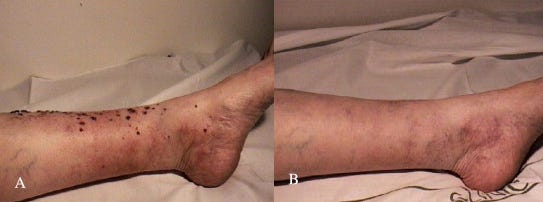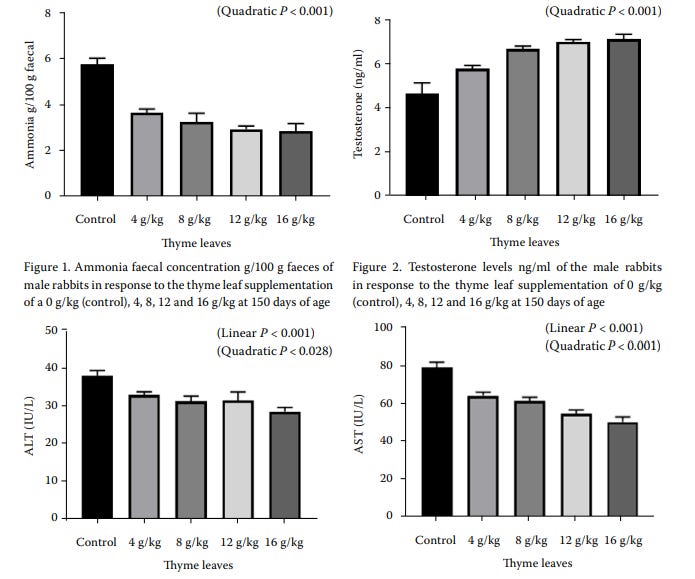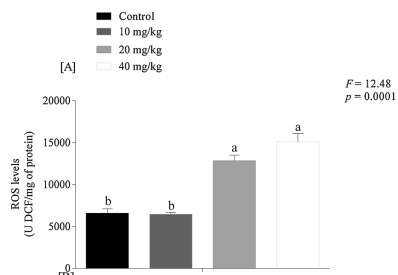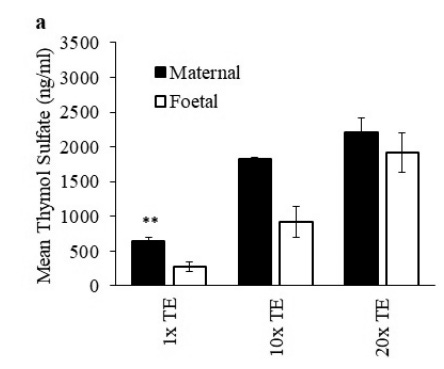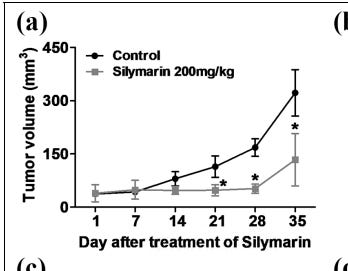#8 Some case reports showing regression or complete remission of tumors
(I found a couple of these mentioned here https://www.cancertreatmentsresearch.com/10-cases-of-complete-remission-from-stage-4-cancers-after-using-supplements-or-repurposed-drugs/)
This woman gained complete remission from metastatic melanoma in a case report over a few weeks.
She said she drank Thyme tea (leaves & stems) and applied it on the area with compresses too
https://jaad.org/article/S0190-9622(04)03675-8/fulltext
Researchers tested this in an animal study.
https://pmc.ncbi.nlm.nih.gov/articles/PMC6479806/#sec2-ijms-20-01749
They showed adding 10g of thyme stems per 1kg diet (though in the actual feeding measures it works out much lower) inhibited the number of new tumors appearing by 53% in the rat carcinogen part of the study, but no significant effect found on size for the ones that appeared.
In the mice part though, using a grafted tumors model instead (breast tumor cells) it showed very impressive effects on stopping growth.
(the 4T1 model is used as an aggressive metastatic type, i think it lacks estrogen receptor A, so doesn’t show if would be similar worse or better for erA expressing tumors. But estrogen signalling can contribute to tumors even without erA https://www.nature.com/articles/s41416-023-02381-0
(Growth stopped, what if it went longer than the 15 days?)
Details on potential for toxicity:
Note: if someone is on thyroid medication, its a good idea to be extra conservative starting thyme as there’s a case report of a women taking a handful and getting symptoms.
(and its a good idea to test low amounts first day for new herbs in case there’s an unknown allergy)
Adding thyme leaves (Thymus vulgaris) to animals diets showed generally great protective effects rising up to 16g/kg.
And showed it was generally safe in rabbits for the liver and kidneys at this amount spread out over the day (measures improved much better than default feeding). https://vetmed.agriculturejournals.cz/pdfs/vet/2020/12/05.pdf
But converting to humans gets complicated.
The half life of thymol in humans is ~10 hours which might be longer than in other mammals. So it could be easier to overdo it, unless differences in oral absorption make up for that.
Its hard to arrive at a reasonable amount comparing animals to humans when there’s potential for toxicity.
Though typical tumor treatments create periods of intense toxicity.
Thymol can become damaging at a certain dose, showing behavioural impairment. (in a mice study at ~100mg and especially ~200mg human “equivalent” dose for a 60kg person), and thyme vulgaris (common thyme) is ~ 0.7% - 1.1% thymol per dry gram.
doi.org/10.1016/j.etap.2018.06.012
https://doi.org/10.1002/jsfa.7031
Going too high lead to increased blood brain barrier leakiness and behavioural impairment. at 20mg/kg ROS levels increased, where they didn’t at 10mg/kg.
That was over 30 days.
In humans, a lower amount as thyme powder improved memory a little, and lowered anxiety scores over a month.
https://www.europeanreview.org/wp/wp-content/uploads/10806-10814.pdf
Bioavailability in animals doesn’t correlate well with humans, often there are large differences. Intestinal absorption correlates well 10.1023/a:1011981317451 but metabolising enzymes in the liver & intestine are very different. Giving wide variability in free concentration in the blood.
https://www.sciencedirect.com/science/article/pii/S0928098713003321#s0055
https://pubmed.ncbi.nlm.nih.gov/16841194/
Waiting for trials for things that might not ever come (with low financial incentive especially) is not a realistic plan. So when people refer to “human equivalent” doses based on animals, the best people/researchers do is base that on a similar bioavailability assumption (even though its varied), unless there’s extra info on blood concentrations in human studies to compare with blood concentrations in animals at doses.
Here blood concentrations in humans from 160mg dry herb with 1.08mg thymol as thymol sulfate hit 93ng/ml of blood https://pubmed.ncbi.nlm.nih.gov/12092740/ They didn’t detect thymol, only the sulfate form which is metabolised from thymol when absorbed.
In rats both 0.6mg/kg thymol in thyme extract (which is ~6mg for a 60kg human going by an estimate for absorption comparison) and 6mg/kg ~60mg didn’t show toxicity https://japsonline.com/admin/php/uploads/3284_pdf.pdf But 60mg/kg did.
Giving them thyme as extract showed ~6mg gave ~600ng/ml thymol sulfate in blood
Giving them isolated thymol at an equivalent amount to what’s in the extract shot their levels up to over 3000ng/ml though and did show toxicity on lower amounts.
So as a best guess, assuming linear response and taking thyme extracted in tea instead of pure thymol,
The ~90ng/ml for ~1mg in humans would be ~540ng/ml for ~6mg which is very close for this. and might give enough insight to say bioavailability is similar. though it doesnt account for possible longer half life for humans allowing some extra buildup.
The current investigation revealed that high doses of thyme extract and its chronic use may alter the placental functions and therefore could affect the growth of fetuses. Based on the results of this study, pregnant females can be advised clinically to use thyme extract only within the recommended doses. Preclinically, further research is still warranted to evaluate the safety of thymol and other thyme constituents on modulating the placental barrier and protein binding. A detailed histological investigation of thyme effects on placental and neonatal vital organs such as the liver and kidneys is also recommended.
The RDD selection was based on prescribing up to 30 mg/day of cough syrup (15 g/100 ml) to pregnant women by healthcare practitioners.
For general use 1x 2g - 3g a day might be ok
I don’t know how much thymol extracts into the water so it’s probably better to swallow the rubbed or powdered leaf (as long as its been rubbed into small amounts, as it doesnt digest larger parts won’t go down too well)
3g might give ~25mg-40mg thymol * + some extra compounds like a little rosmarinic acid. under that 60mg amount and under the 100mg from the mice study that started to show toxicity for them. which gives some extra room if it does build up a bit with a possibly longer half life.
If I notice memory impairment i’ll take a break then half the amount.
The breast tumor study showed similar effect between the low dose and high dose so it looks like there’s a wide range for efficacy.
But I don’t know if there’s further results to be gained in certain areas with short term use higher.
{ Side one worth adding, giving animals a hot water extract of thyme also showed a complete reversal of hypothyroidism where t4 → t3 conversion was blocked, by 4 weeks
https://pubs.sciepub.com/jfnr/7/11/6/index.html
Case 2
This person with a liver tumor had temporary regression, shrinking it to half its size. He took 450mg of silymarin from milk thistle a day. but the effects stalled and it re-grew after around a year.
https://pmc.ncbi.nlm.nih.gov/articles/PMC2769275/
Ultrasonography in our outpatient department revealed a large tumour with central necrosis, measuring about 11 cm in diameter,
CT scan of the liver was performed again and revealed HCC regression, with tumour size reduced to about 4.6 cm in diameter, and portal vein thrombosis (Figure 3).
Silymarin 450 mg daily was the only regularly prescribed medicine during HCC reduction.
The tumour size did not contract persistently as shown by abdominal echo. CT scan of the liver was performed prior to the surgery, revealing an HCC size similar to the previous readings and portal vein thrombosis.
Silymarin inhibits the transport of thyroid hormone, so not good for general use.
In an animal test using human squamous cell carcinoma, feeding high amounts of silymarin shrank pre-existing tumors.
http://doi.org/10.1093/carcin/23.3.499
Giving 200mg/kg orally to mice (around 1g - 1.5g human equivalent), 5 days a week for 5 weeks didn’t cause kidney or liver toxicity.
It stalled growth very well in an oral tumor until the end, but didnt get to the regression seen above at this frequency (or possibly tumor type).
10.1177/1010428318776170
There are reports of certain therapeutic approaches re-gaining effectiveness after stalling, when tetracycline antibiotics are given https://rupress.org/jem/article/218/9/e20210571/212494/Activation-of-the-integrated-stress-response
So if some similar mechanisms are shared here, I wonder if intermittent doxycycline would have kept the regression going into remission. Or something else added alongside if not.
Case 3
A case of complete & sustained remission in a man with Lymphocytic Leukemia , who used high doses of ECGC. Though these doses have toxicity at least to the liver
https://pubmed.ncbi.nlm.nih.gov/26858922/
Case 4
Sometimes “spontaneous” remission happens when someone gets an extreme infection. possibly due to the extreme immune response, if not viral infiltration & or heavy treatment protocols, but that wasn’t mentioned here.
A man with non-hodgkin b cell lymphoma switched to a combination of herbs after rejecting another round of chemo. After 2 months he didn’t have the mass any more.
https://pmc.ncbi.nlm.nih.gov/articles/PMC9900160/#section2-15347354221147515
The patient achieved a long-term complete remission and good quality of life over an 8-year follow-up under maintenance care of CHM. To the best of our knowledge, this is the first complete case report on DHL involving CHM.
cases reveal that DHL has a poor prognosis and there is no accepted standard of treatment for DHL. The aggressive immunochemotherapy limits the outcome due to adverse effects or the intolerance of the patients.Because of intolerance to the intensive chemo-immunotherapy, he stopped the chemotherapy at the third cycle about 7 weeks before he was recommended to our clinic in March 2014. It should be noted that this patient came to Chinese medicine treatment 7 weeks after the third cycle of chemo-immunotherapy which is longer than the usual 4 weeks from prior treatment.
Follow-up CT imaging on the neck, chest, abdomen, and pelvis in May 2014 showed that the right iliac fossa mass had resolved with no residual mass.
The basic prescription was Sijunzi Decoction plus Prunella vulgaris with raw herbs used from March 2014 to March 2017 including
Prunella vulgaris 20 g, Sophora flavescens 12 g, Scutellaria baicalensis 15 g, Salvia miltiorrhiza 12 g, Codonopsis pilosula 15 g, Atractylodes macrocephala 12 g, Poria cocos 15 g, and Glycyrrhiza uralensis 5 g.
The herbs in the prescriptions were amended according to the patient’s responses. The CHM was administered daily in 2 separate decoctions: for the first decoction, 1000 ml of cold water was added to the herbal mixture, which was then boiled for approximately 50 minutes to reduce the volume to about 250 ml. This decoction was taken each morning. The remaining herbal mixture was used for making a second decoction which was taken each afternoon. This was prepared by using 750 ml of cold water and boiled for approximately 30 minutes to reduce the volume to about 200 ml.
More cases
I’ll put up a separate post of William Koch’s findings and some modern follow up trials using his approach. https://archive.org/details/TheChemistryOfNaturalImmunityWilliamKoch/page/n101/mode/


